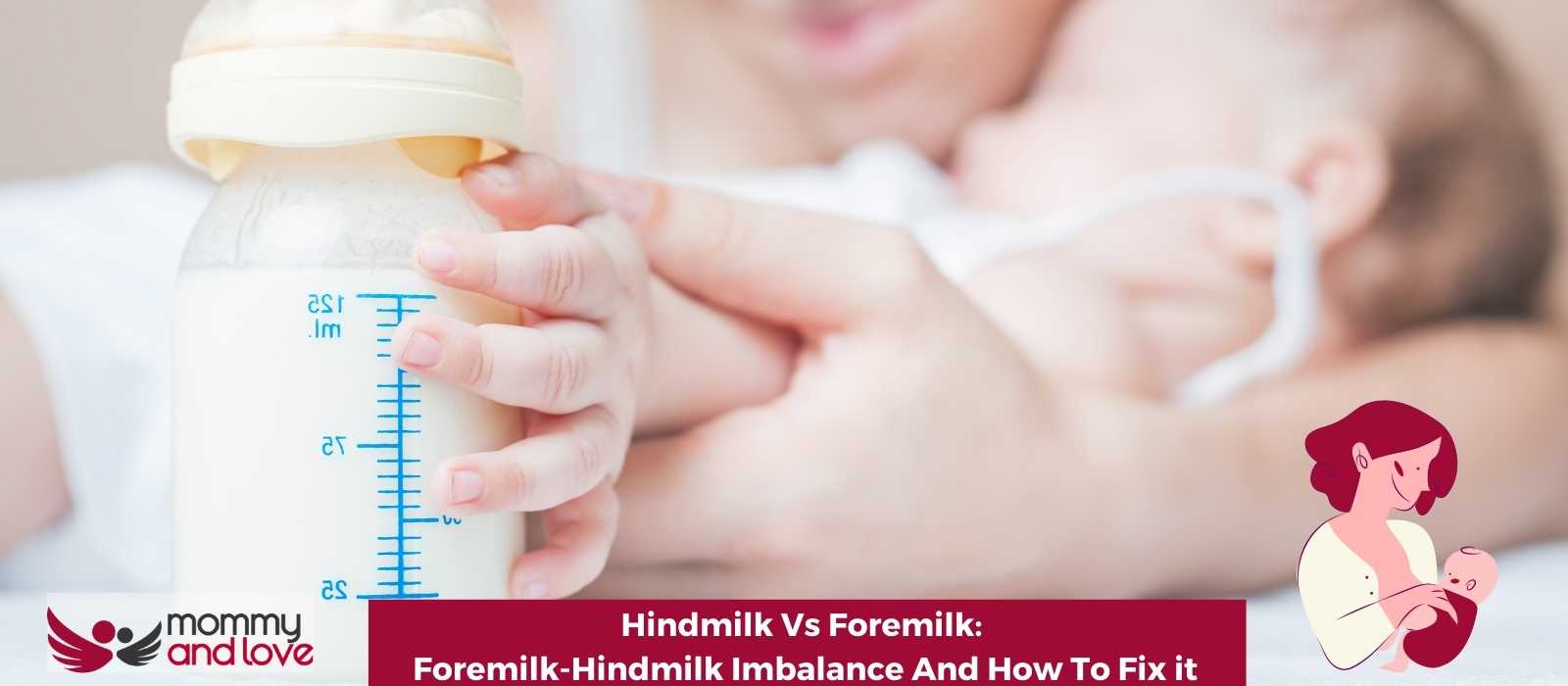If you breastfeed your child or plan to breastfeed you may feel overwhelmed with information. The Hindmilk vs Foremilk debate can cause a lot of anxiety in moms.
Although you may have lots of questions concerning breastfeeding, the best thing you can do is relax and take one day at a time. You could also check out our advice on everything you need to know about breastfeeding.
Sometimes that’s easier to say than to do. If you’ve been studying breastfeeding, you may be aware of both foremilk and hindmilk, and you may be stressing about whether your breast milk can really give your baby everything he needs to thrive.
Let’s look at what you need to know about foremilk and hindmilk.
Tell Me The Difference Between Hindmilk and Foremilk?

Amazingly, human milk changes throughout a feed to ensure that baby gets everything he needs. The foremilk is the first milk that your child will have when you put him to the breast, this watery milk will satisfy his thirst and is mainly water and nutrients.
Hindmilk is the high-fat milk that your child will get gradually as feeding progresses, towards the end of the feed. This higher fat milk helps make your baby feel full and content.
Moms often stress about foremilk and hindmilk balance unnecessarily; Kelly Bonyata, IBCLC and writer over at Kellymom, emphasises that most of the time, moms needn’t worry at all your milk is catered to your baby and providing your child is gaining weight appropriately, all signs are good!
Hindmilk And Foremilk, Which Is Better?
As we mentioned before, your infant is likely to have the more watery, low fat milk when you start feeding him.
As the feed progresses and the breast empties, your baby will begin to access hindmilk. This is a gradual proces, this is because the fat sticks within the milk ducts, however as the breast drains, that fatty milk is pulled down as your baby nurses.
Remember that the change is gradual, rather than there being two distinct types of milk. The main difference is in fat content, and foremilk and hindmilk carry equal importance to ensure the proper nutritional intake of your baby or toddler.
All breast milk is precious!
What is Foremilk/Hindmilk Imbalance?
Foremilk/hindmilk imbalance is caused when babies consume almost exclusively foremilk, filling up on the lower fat content milk before they get to the fatty hindmilk.
As a result, you may find that your baby is gaining weight slowly or shows other symptoms such as explosive nappies, or a few dirty diapers.
You might think that if your baby is having trouble gaining weight you must increase milk production, but actually, very often where there is foremilk hindmilk imbalance, mom has abundant, sometimes overabundant supply!
The issue isn’t really how much your milk is taking, but that there is not enough fat in the milk they are having.
What Causes the Foremilk/hindmilk Imbalance?
This can happen when mothers have an oversupply of milk or babies switch breasts frequently during nursing sessions.
If your baby fills up on lactose rich foremilk and not enough hindmilk, you may find that they don’t gain weight as expected.
This occurs less often when you are exclusively pumping, as your infant gets a bottle that contains both fore and hindmilk. If you do pump, take a look at the bottles you have in the fridge, you may notice a separation between the watery foremilk and the higher fat content settling at the top.
Your Baby’s Symptoms

Foremilk and breastmilk imbalances are very similar for children with digestive or lactatose intolerance.
They are likely to show some or all of these symptoms:
Your baby may be gassy, uncomfortable and unsettled. If they are taking too much foremilk, you may notice green stools or frothy dirty diapers.
Too much foremilk can be lactose overload for your baby and his immature digestive system, so often the diapers are the biggest symptom moms report.
Lactose overload causes any undigested lactose to go to the large intestine, which is fermented and produces gas.
Weight gain may be slow if your baby is having too much watery milk during a nursing session, skipping the hindmilk which has more fat, essential for their growth.
Hindmilk imbalance can be caused by oversupply, so if your baby drinks very quickly or splutters at the breast, you may need to help baby manage the milk flow.
How Do You Know if Baby Is Getting Hindmilk?
Look for a happy, settled baby with healthy weight gain and reasonably good sleep. If your baby isn’t showing symptoms you are worried about, let nature do its thing and don’t worry about foremilk hindmilk imbalance!
Foremilk hindmilk imbalance is just one of many issues that may cause your baby to be unsetttled or to wake throughout the night as they grow- simply put, if they are only getting that watery part of your breast milk, they will look for more milk very regularly, as the last feed simply didn’t fill them!
How Long Does It Take For Baby To Get Hindmilk?
This really varies massively! It might take 10-15 minutes for your child to drain one breast, and they should access more hindmilk towards the end of that time frame. That said, how much milk you have, and how efficient a feeder your baby will affect this.
When Should You Be Concerned About an Imbalance?
Always speak to a lactation consultant if you are worried!
However, many lactation consultants state that foremilk/hindmilk imbalance is rare and can often be dealt with by getting into a good feeding routine.
Many people feel anxious about foremilk and hindmilk after their babies have a bout of green stool, however…green poop is often caused by eating a vegetable, a reaction to dairy products, food colouring, teething, a virus or minor digestive disorder, or starting solids.
Remember, your baby’s digestive system is still immature and learning! Your body produces milk that is tailor made to your little one- trust it!
In cases where green poop is accompanied by not enough weight gain or an unsettled baby, contact your paediatrician for advice.
Is More Milk The Answer?
Probably not!
Remember that breastfeeding works by supply and demand, if you are producing very large volumes of breast milk, you increase the risk that your baby will get even foremilk, which can lead to lactose overload, and missing out on other nutrients such as fats and protein found in the hindmilk.
How Do I Ensure That My Breast Milk Has Enough Fat Content For My Baby?
If oversupply is the issue, the best thing you can do to tackle foremilk and hindmilk imbalance is to feed your baby as normal and allow your breast milk supply to settle naturally.
It may help to have a short pumping session before you feed your baby; alternatively, when you are nursing and feel let down commence, unlatch your baby and express off some of the excess milk in a separate container. This prevents your little one from getting more foremilk than they need.
Always ensure that your baby has drained the first breast before offering the other breast- this ensures that they get enough hindmilk and are not just lazily taking the watery foremilk that comes with little effort!
Block feeding is a great method to tackle foremilk and hindmilk imbalance; this is where your breasts effectively take shifts!
Feed from one breast for a set time, perhaps 3-4 hours, to ensure that the breast is being completely drained of breastmilk. Then move to the other breast, back and forth. This should ensure that both breasts are thoroughly emptied.
How Much Hindmilk Is Too Much?
It’s unlikely that your baby is having too much hindmilk- though breastfed babies are known for being chubby! Your breast milk is the perfect food for your baby, protecting them from all sorts of health conditions and supporting their emotional development too.
As long as your baby is feeding on both breasts regularly and meeting their milestones, there is probably nothing to worry about!
My Baby drinks From the Breast All Day, Is My Milk Not Enough?
Breast milk is designed to be easily digested, and as such, babies tend to feed very often! The advice is to feed on demand, giving your infant free access to your breasts and feeding for as long as they like.
If you want to know what’s normal, check out our blog post packed with Breastfeeding advice for new moms.
If you are worried that they aren’t getting enough breast milk generally, feed them more! Encourage a deeper latch and offer one breast at a time, allowing a full feeding session before moving on to the other.
Always speak to your lactation consultant if concerned, very often they can quickly put your mind at ease.

The Low Down On Foremilk and Hindmilk Imbalance
Foremilk is the watery part of your milk, which your baby has in abundance at the start of a feed. As the feed progresses, fatty hindmilk begins to be pulled down. This fatty component helps your baby feel full and gain weight.
The chances are that the composition of your breast milk is just fine and that you have nothing to worry about. Lactation consultants report true Foremilk-Hindmilk imbalance to be incredibly rare.
If you are having issues, contact your paediatrician or lactation consultant for advice tailored to your situation.

This article was written by Sandra Baker – full time writer and the mother of four amazing kids (including twins!)
She’s also a breastfeeding counselor and has spent years helping new parents learn how to care for their children. When she’s not writing or caring for her children, Sandra likes to spend time reading and taking walks with her husband.




